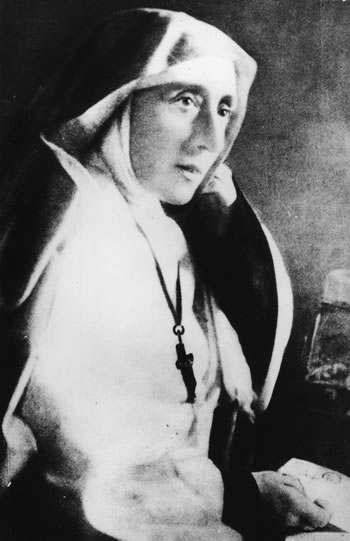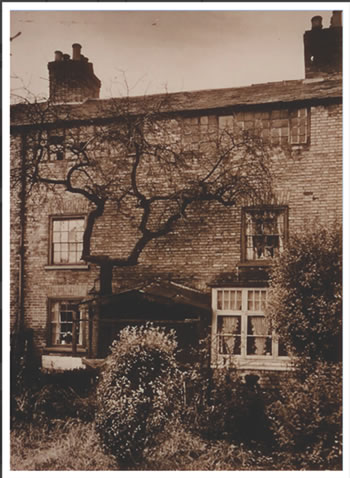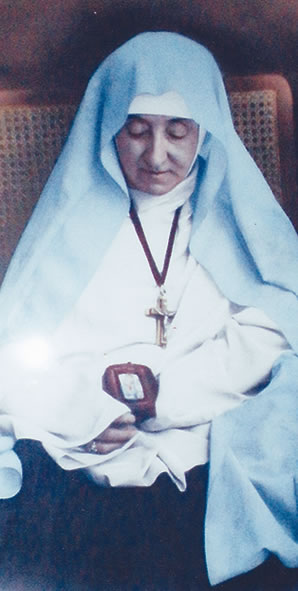Little Company of Mary celebrates Centenary of the death of Foundress
 Tribute to Venerable Mary Potter
Tribute to Venerable Mary Potter
by Sr Mary Scanlon LCM
In the early evening of 9th April 1913, Mary Potter, founder of the Little Company of Mary, died at Calvary, Rome. It was not an uncommon dying. There was no struggle, no agony. According to eye witnesses, “she gave a small cry and went to Him whom she loved and for whom she had suffered so much.” She was 65 years old, in the 35th year of Religious Profession, and it was thirty-six years and three months from the day she had disembarked from the train in Nottingham, England. This Year of Grace 2013 is a milestone in our congregation as we celebrate the centenary of that historic moment in Rome 100 years ago.
What surprised Mary’s community was the effect of her death. All through the night and in the following two days, an incessant stream of people of all ranks in life came to kneel beside her bed, to pray and to kiss her hand. Mother Cecilia recalls: “She was visited by crowds, rich and poor, especially the latter to whom she had always been kind and generous. I shall never forget one old man who sobbed bitterly… We had to leave the door open all night to accommodate them all.”
To shed some light on the woman whose death made such an impact in Rome, let’s listen again to her story.
Mary was born in London on 22 November 1847 to William Norwood Potter and Mary Anne (Martin) Potter, both of the Anglican faith. Mary was the only girl after 4 sons and was born with a serious heart condition which caused her intense suffering all her life. Mrs. Potter, impressed with the faith of the Irish immigrant women around her, was converted to Catholicism when pregnant with Mary By the time of Mary’s birth, the Potters’ marriage was in trouble, owing mainly to William’s poor business acumen (he was virtually bankrupt by 1847) and his dour personality. When Mary was but a year old, he left the family and fled to Australia to escape a bankrupt’s fate. Mrs. Potter reared the 5 young children largely on her own, with some financial help from her extended family. Because of her frailty, Mary was educated at a private academy and learned the skills of a young woman of lower middle class for those times. Nature compensated for her frailty by endowing her with a lively and charming personality, and she was always popular. When she was in her teens, Mary and her mother moved down to Portsmouth, a garrison town, to live with her brother Thomas and his French wife Marguerite.
Engagement

The pear tree reputedly planted by Mary Potter was situated in the garden of the first LCM convent -“the old stocking factory” in Hyson Green Nottingham. From the wood of this tree a large crucifix was made which now hangs in the LCM Heritage Centre, Nottingham.
Thomas would bring home his friends and one was a young man, Godfrey King. He was attracted to Mary and they became engaged. Godfrey, a serious young man, misunderstood Mary’s sunny disposition, regarding her as “shallow.” He plied her with religious books but this backfired, for Mary’s already strong faith was moved and she became aware of a call to live for God, not with Godfrey! She broke off her engagement to Godfrey and, after consultation with her local bishop, entered the Sisters of Mercy novitiate in Brighton. She was then a sickly but vibrant 21-year-old. Her frail health broke down under the intense discipline of convent life, and her deep devotion to prayer was also ridiculed as she was termed “imaginative”! She was advised to leave the convent, so returned to her mother, broken in health and spiritually depleted. In her pain and isolation, Mary spent long hours in prayer, and found herself drawn ever more deeply into the scene of Calvary, with Christ dying in appalling agony and Mary his faithful mother in silent yet active presence at his side. It seemed to Mary Potter that God was calling her to a closer awareness of the dying and their needs.
Foolhardy Scheme
During 1874 Mary began to experience this call more urgently, a call to establish a religious group devoted to the spiritual assistance of the sick and dying. Mrs. Potter was totally opposed to the idea and was very controlling of Mary. Eventually however Mary’s call was realized in an unexpected way. Bishop Bagshawe of the Nottingham diocese heard of Mary, through her reputation for sanctity and her published writings on Marian themes, and he began a correspondence with her. Mary believed the bishop would help her and she tried to obtain her mother’s blessing to go to Nottingham, but Mrs. Potter was adamant that she would never allow Mary to leave her home again. Matters came to a dramatic turn in January 1877, when Mary was 29 years old and apparently failing in her dream. One morning, she and Marguerite attended Mass where the gospel of the day was that of the boy Jesus “lost in the temple.” Suddenly, Mary knew what she had to do. She boarded a train to London, stayed overnight with her brother Henry, and next day boarded a train to Nottingham, spending 8 hours in a steam train in the middle of winter! She arrived at the Bishop’s residence in the early evening, to the surprise of Bishop Bagshawe, but he received her well enough and encouraged her to find accommodation, which she did in an old stocking factory in the suburb of Hyson Green. There, in the rambling and freezing old building, the Little Company of Mary had its roots.

Stylised drawing of the pear tree by Marie Angel, great-niece of Venerable Mary Potter, incorporating the psalm verse which expressed the heart of LCM spirituality.
Birth of the Congregation
Bishop Bagshawe, a good man and one intent on developing his diocese following Catholic emancipation, realized Mary’s potential for his diocese, but he also had another agenda, as we shall see. Four young women, impressed by Mary’s holiness and clear purpose, joined her, and on 2nd July 1877 the Little Company of Mary was born. The characteristics of the new congregation, written in Mary Potter’s heart out of the years of suffering, were: to live in the heart of the Paschal Mystery; in companionship with Mary, Christ’s mother; as a community of celibate women in simplicity of lifestyle; and to pray for and minister to the sick, suffering and dying. Mary’s years of suffering had honed her into a true contemplative, hence her emphasis on the Sisters being women of prayer whose ministries flowed from their union with God. These elements are reflected in the name she gave the congregation: The Little Company of Mary
Trials
The early months of the new congregation were filled with trials and anxiety: extreme poverty, poor housing, and Mary’s ill health, to mention a few. Then, when the congregation was only a few weeks old, Bishop Bagshawe declared himself to be the “Higher Superior,” deposed Mother Mary, as she was now called, and installed a young and inexperienced Sister as Superior. He hoped to retain the Little Company of Mary within his own diocese. Mother Mary was sent out to beg. She contracted both typhoid fever and tuberculosis, which were endemic among the poor people she visited, and she remained extremely ill for a long time. She went on to develop primary cancer in each breast and surgery was dreadfully painful because Mary could have only minimal anaesthesia due to her heart condition. Meanwhile, under the leadership of the inexperienced Sister, the fledging congregation began to falter. Two years after deposing her, Bishop Bagshawe realized his mistake and reinstated Mary, while continuing to use all means at his disposal to have control of the Little Company of Mary, and to keep it within his diocese. Mary’s vision, on the other hand, was of worldwide groups of women praying for and working with the sick, suffering and dying.
Rome
Needing to address this issue of Bishop Bagshawe’s control and to gain approval for the new congregation, Mary Potter struggled to Rome 1882. Pope Leo XIII welcomed her and declared: “The doors of Rome are open to you!” Mary drafted a Constitution which in due course the Holy Father approved, and Mother Mary was able to mould her young congregation according to the charism gifted her by God during her years of pain, isolation, misunderstanding and ridicule. Young women joined in both Nottingham and Rome, and Mary Potter established formation houses and nurses’ training schools, for in her wisdom and foresight she wished the Sisters to be formed both as good Religious and fully-trained professional nurses. The congregation, small though it was, spread quickly and by 1885 had even taken root in Australia, whence the foundations in Aotearoa New Zealand sprang from 1913 onwards. In fact, Mother Mary knew of the move to New Zealand before her death, so the Sisters in this country experience a special connection with her.
Death
On 9th April 1913, worn out by pain and suffering, yet calmly and with a joyful smile, Mother Mary died peacefully in the early evening. Her remains were transferred from Rome to Nottingham Cathedral, with great solemnity, in 1997.
A model for our times
Mary Potter had a deep abiding sense of being loved utterly and intimately by God, and of being very close to Mary the mother of Jesus. Loving God in return meant for her loving everyone and everything God had made. Her values of respect for all life, compassion and solidarity with those suffering included respect for all creation. She therefore instructed that the Sisters be fully engaged with the world, not divorced from it. The Sisters today describe themselves thus: “In response to Love, Jesus gave his life for all. In saying her ‘Yes,’ Mary stood in faith, compassion and solidarity with her Son Jesus and with all who were on Calvary. Today Calvary is experienced where life is threatened or destroyed, or where suffering and need exist. As companions of Mary at the foot of the cross, we are called to be a compassionate and prayerful presence, birthing to life God’s love in the many sufferings and dyings of our world.”
On 9th April, the Little Company of Mary Sisters worldwide will celebrate the centenary of the death of Mary Potter: faithful and valiant woman who through her sufferings birthed to life God’s love and Mary’s compassion for the sick, suffering and dying, and bequeathed that charism to her congregation.
Venerable Mary Potter, pray for us!
 Entries(RSS)
Entries(RSS)